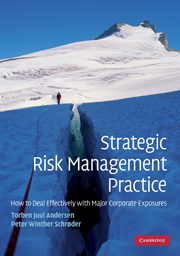Book contents
- Frontmatter
- Contents
- List of abbreviations
- List of figures
- List of tables
- List of boxes
- Preface
- 1 The strategic nature of corporate risk management
- 2 Economic exposures in corporate risk management
- 3 Managing market-related business exposures
- 4 Extending the risk management perspective
- 5 Integrative risk management perspectives
- 6 Current risk management practice and the rise of ERM
- 7 Strategic risk analyses
- 8 Strategic risk management – amendments to the ERM framework
- 9 Strategic risk management
- 10 Postscriptum
- Appendices
- Appendix 1 A strategic responsiveness model
- Appendix 2 Determining the premium on a call option
- Appendix 3 Determining the value of a real option
- Index
- References
10 - Postscriptum
Published online by Cambridge University Press: 05 June 2012
- Frontmatter
- Contents
- List of abbreviations
- List of figures
- List of tables
- List of boxes
- Preface
- 1 The strategic nature of corporate risk management
- 2 Economic exposures in corporate risk management
- 3 Managing market-related business exposures
- 4 Extending the risk management perspective
- 5 Integrative risk management perspectives
- 6 Current risk management practice and the rise of ERM
- 7 Strategic risk analyses
- 8 Strategic risk management – amendments to the ERM framework
- 9 Strategic risk management
- 10 Postscriptum
- Appendices
- Appendix 1 A strategic responsiveness model
- Appendix 2 Determining the premium on a call option
- Appendix 3 Determining the value of a real option
- Index
- References
Summary
The preceding nine chapters have covered many aspects of risk management, ranging from highly developed techniques dealing with different financial market volatilities and insurable risk phenomena to newer enterprise-wide approaches that also try to incorporate operational and strategic exposures. The discussion throughout these chapters has revealed a number of technical and rather sophisticated approaches to dealing with specific types of risk in highly professionalized market contexts. This clearly illustrates that a high degree of specialization is needed if organizations want to take advantage of the wide possibilities to obtain covers for and hedge against different exposures. These professional risk markets continue to evolve and introduce new opportunities to diversify excess exposures. At the same time, the discussions uncover a need to consider how different risks may interact and thereby show potential conjoint effects on aggregate corporate exposures. To the extent that the corporation is faced with positive or negative co-variations between some of the essential risk factors, there is a need to assess corporate exposures on an enterprise-wide basis. This overarching concern has obviously been an essential motivator for the introduction of different enterprise risk management frameworks that try to embrace all types of corporate exposures. As appears, the concerns for different sets of professional risk expertise and integrative considerations of corporate exposures point towards the simultaneous needs for professional skills dispersed within the organization and centralized analytical competencies.
- Type
- Chapter
- Information
- Strategic Risk Management PracticeHow to Deal Effectively with Major Corporate Exposures, pp. 225 - 230Publisher: Cambridge University PressPrint publication year: 2010



